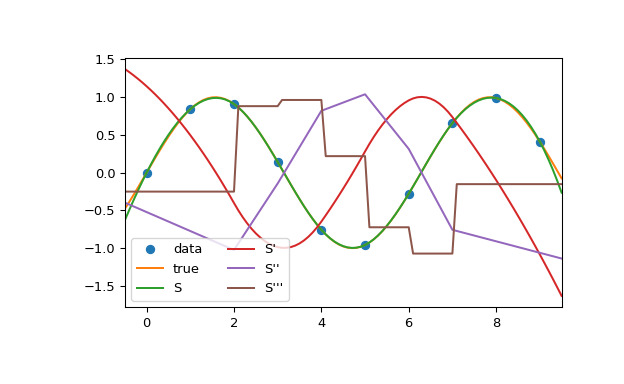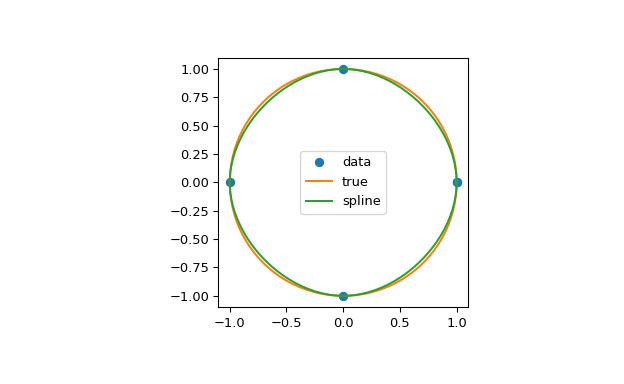本文簡要介紹 python 語言中 scipy.interpolate.CubicSpline 的用法。
用法:
class scipy.interpolate.CubicSpline(x, y, axis=0, bc_type='not-a-knot', extrapolate=None)#三次樣條數據插值器。
使用兩次連續可導的分段三次多項式對數據進行插值 [1]。結果表示為
PPoly實例,其中斷點與給定數據匹配。- x: 數組, 形狀 (n,)
包含自變量值的一維數組。值必須是實數、有限且嚴格遞增的。
- y: array_like
包含因變量值的數組。它可以有任意數量的維度,但沿
axis的長度(見下文)必須與x的長度匹配。值必須是有限的。- axis: 整數,可選
沿哪個軸y假設是變化的。這意味著對於
x[i]對應的值為np.take(y, i, axis=axis).默認值為 0。- bc_type: 字符串或 2 元組,可選
邊界條件類型。需要由邊界條件給出的兩個附加方程來確定每個段 [2] 上多項式的所有係數。
如果bc_type 是字符串,則指定的條件將應用於樣條曲線的兩端。可用條件為:
‘not-a-knot’(默認):曲線末端的第一段和第二段是相同的多項式。當沒有關於邊界條件的信息時,這是一個很好的默認值。
‘periodic’:假設插值函數是周期性的
x[-1] - x[0].的第一個和最後一個值y必須相同:y[0] == y[-1].這個邊界條件將導致y'[0] == y'[-1]和y''[0] == y''[-1].‘clamped’:曲線末端的一階導數為零。假設一維y,
bc_type=((1, 0.0), (1, 0.0))是相同的條件。‘natural’:曲線末端的二階導數為零。假設一維y,
bc_type=((2, 0.0), (2, 0.0))是相同的條件。
如果bc_type 是一個二元組,則第一個和第二個值將分別應用於曲線的起點和終點。元組值可以是前麵提到的字符串之一(‘periodic’ 除外)或允許在曲線末端指定任意導數的元組(順序,deriv_values):
order:導數順序,1 或 2。
deriv_value: 數組 包含導數值,形狀必須相同y, 不包括
axis方麵。例如,如果y是一維的,那麽deriv_value必須是標量。如果y是 3-D,形狀為 (n0, n1, n2) 且軸 = 2,則deriv_value必須是二維的並且具有 (n0, n1) 的形狀。
- extrapolate: {bool,‘periodic’,無},可選
如果是布爾值,則確定是根據第一個和最後一個間隔外推到越界點,還是返回 NaN。如果‘periodic’,使用周期性外推。如果 None (默認),
extrapolate設置為 ‘periodic’ 用於bc_type='periodic',否則設置為 True。
參數 ::
注意:
參數bc_type和
extrapolate獨立工作,即前者僅控製樣條的構造,而後者僅控製評估。當邊界條件為“not-a-knot”且 n = 2 時,將其替換為一階導數等於線性插值斜率的條件。當兩個邊界條件均為“not-a-knot”且 n = 3 時,求解作為通過給定點的拋物線尋求。
當 'not-a-knot' 邊界條件應用於兩端時,生成的樣條曲線將與
splrep(使用s=0)和InterpolatedUnivariateSpline返回的樣條曲線相同,但這兩種方法使用 B-spline 基礎中的表示.參考:
[1]Cubic Spline Interpolation 在維基學院。
[2]Carl de Boor,“樣條曲線實用指南”,Springer-Verlag,1978 年。
例子:
在此示例中,三次樣條用於內插采樣的正弦曲線。您可以看到樣條連續性屬性適用於一階和二階導數,僅違反三階導數。
>>> import numpy as np >>> from scipy.interpolate import CubicSpline >>> import matplotlib.pyplot as plt >>> x = np.arange(10) >>> y = np.sin(x) >>> cs = CubicSpline(x, y) >>> xs = np.arange(-0.5, 9.6, 0.1) >>> fig, ax = plt.subplots(figsize=(6.5, 4)) >>> ax.plot(x, y, 'o', label='data') >>> ax.plot(xs, np.sin(xs), label='true') >>> ax.plot(xs, cs(xs), label="S") >>> ax.plot(xs, cs(xs, 1), label="S'") >>> ax.plot(xs, cs(xs, 2), label="S''") >>> ax.plot(xs, cs(xs, 3), label="S'''") >>> ax.set_xlim(-0.5, 9.5) >>> ax.legend(loc='lower left', ncol=2) >>> plt.show()
在第二個例子中,單位圓是用樣條插值的。使用周期性邊界條件。您可以看到周期點 (1, 0) 處的一階導數值 ds/dx=0, ds/dy=1 被正確計算。請注意,圓不能用三次樣條精確表示。為了提高精度,需要更多的斷點。
>>> theta = 2 * np.pi * np.linspace(0, 1, 5) >>> y = np.c_[np.cos(theta), np.sin(theta)] >>> cs = CubicSpline(theta, y, bc_type='periodic') >>> print("ds/dx={:.1f} ds/dy={:.1f}".format(cs(0, 1)[0], cs(0, 1)[1])) ds/dx=0.0 ds/dy=1.0 >>> xs = 2 * np.pi * np.linspace(0, 1, 100) >>> fig, ax = plt.subplots(figsize=(6.5, 4)) >>> ax.plot(y[:, 0], y[:, 1], 'o', label='data') >>> ax.plot(np.cos(xs), np.sin(xs), label='true') >>> ax.plot(cs(xs)[:, 0], cs(xs)[:, 1], label='spline') >>> ax.axes.set_aspect('equal') >>> ax.legend(loc='center') >>> plt.show()
第三個例子是多項式 y = x**3 在區間 0 <= x<= 1 上的插值。三次樣條可以精確地表示這個函數。為了實現這一點,我們需要在區間的端點處指定值和一階導數。請注意,y' = 3 * x**2,因此 y'(0) = 0 和 y'(1) = 3。
>>> cs = CubicSpline([0, 1], [0, 1], bc_type=((1, 0), (1, 3))) >>> x = np.linspace(0, 1) >>> np.allclose(x**3, cs(x)) True- x: ndarray,形狀(n,)
斷點。傳遞給構造函數的相同
x。- c: ndarray,形狀(4,n-1,...)
每個段上多項式的係數。尾隨尺寸與y, 不包括
axis.例如,如果y是一維,那麽c[k, i]是一個係數(x-x[i])**(3-k)在之間的段x[i]和x[i+1].- axis: int
插值軸。傳遞給構造函數的同一軸。
屬性 ::
相關用法
- Python SciPy interpolate.CloughTocher2DInterpolator用法及代碼示例
- Python SciPy interpolate.make_interp_spline用法及代碼示例
- Python SciPy interpolate.krogh_interpolate用法及代碼示例
- Python SciPy interpolate.InterpolatedUnivariateSpline用法及代碼示例
- Python SciPy interpolate.BSpline用法及代碼示例
- Python SciPy interpolate.LSQSphereBivariateSpline用法及代碼示例
- Python SciPy interpolate.griddata用法及代碼示例
- Python SciPy interpolate.splder用法及代碼示例
- Python SciPy interpolate.LinearNDInterpolator用法及代碼示例
- Python SciPy interpolate.PPoly用法及代碼示例
- Python SciPy interpolate.NdBSpline用法及代碼示例
- Python SciPy interpolate.pade用法及代碼示例
- Python SciPy interpolate.barycentric_interpolate用法及代碼示例
- Python SciPy interpolate.RegularGridInterpolator用法及代碼示例
- Python SciPy interpolate.NdPPoly用法及代碼示例
- Python SciPy interpolate.interp2d用法及代碼示例
- Python SciPy interpolate.approximate_taylor_polynomial用法及代碼示例
- Python SciPy interpolate.RectSphereBivariateSpline用法及代碼示例
- Python SciPy interpolate.sproot用法及代碼示例
- Python SciPy interpolate.splantider用法及代碼示例
- Python SciPy interpolate.interp1d用法及代碼示例
- Python SciPy interpolate.BPoly用法及代碼示例
- Python SciPy interpolate.BarycentricInterpolator用法及代碼示例
- Python SciPy interpolate.splrep用法及代碼示例
- Python SciPy interpolate.make_smoothing_spline用法及代碼示例
注:本文由純淨天空篩選整理自scipy.org大神的英文原創作品 scipy.interpolate.CubicSpline。非經特殊聲明,原始代碼版權歸原作者所有,本譯文未經允許或授權,請勿轉載或複製。
